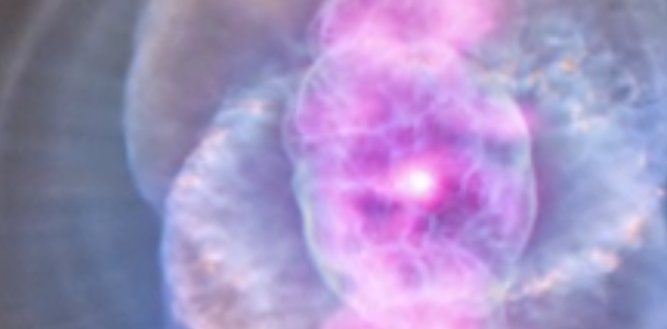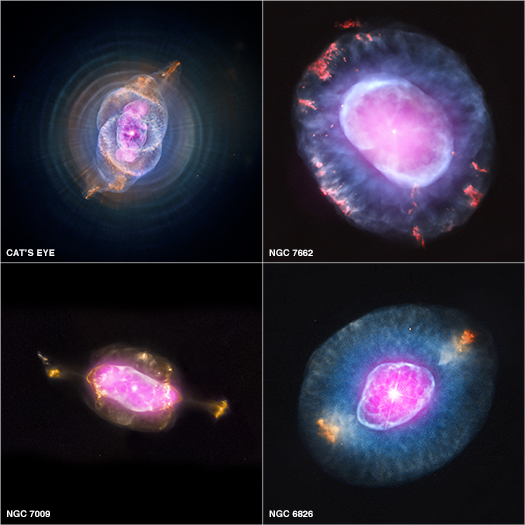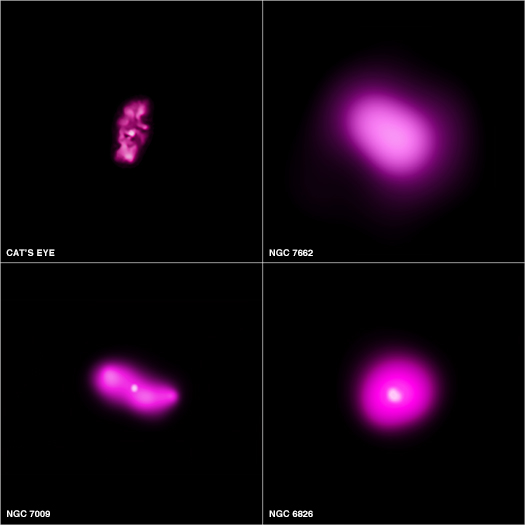Stellar evolution – Chandra delivers first systematic survey of nebulas in solar neighborhood

This gallery shows four planetary nebulas from the first systematic survey of such objects in the solar neighborhood made with NASA’s Chandra X-ray Observatory. The planetary nebulas shown here are NGC 6543, also known as the Cat’s Eye, NGC 7662, NGC 7009 and NGC 6826. In each case, X-ray emission from Chandra is colored purple and optical emission from the Hubble Space Telescope is colored red, green and blue.
In the first part of this survey, published in a new paper, twenty one planetary nebulas within about 5000 light years of the Earth have been observed. The paper also includes studies of fourteen other planetary nebulas, within the same distance range, that Chandra had already observed.
These results were published in the August 2012 issue of The Astronomical Journal. The first two authors are Joel Kastner and Rodolfo Montez Jr. of the Rochester Institute of Technology in New York, accompanied by 23 co-authors.
A planetary nebula represents a phase of stellar evolution that the sun should experience several billion years from now. When a star like the sun uses up all of the hydrogen in its core, it expands into a red giant, with a radius that increases by tens to hundreds of times. In this phase, a star sheds most of its outer layers, eventually leaving behind a hot core that will soon contract to form a dense white dwarf star. A fast wind emanating from the hot core rams into the ejected atmosphere, pushes it outward, and creates the graceful, shell-like filamentary structures seen with optical telescopes.



The diffuse X-ray emission seen in about 30% of the planetary nebulas in the new Chandra survey, and all members of the gallery, is caused by shock waves as the fast wind collides with the ejected atmosphere. The new survey data reveal that the optical images of most planetary nebulas with diffuse X-ray emission display compact shells with sharp rims, surrounded by fainter halos. All of these compact shells have observed ages that are less than about 5000 years, which therefore likely represents the timescale for the strong shock waves to occur.
About half of the planetary nebulas in the study show X-ray point sources in the center, and all but one of these point sources show high energy X-rays that may be caused by a companion star, suggesting that a high frequency of central stars responsible for ejecting planetary nebulas have companions. Future studies should help clarify the role of double stars in determining the structure and evolution of planetary nebulas.
| Fast Facts for NGC 6543: | |
| Credit | X-ray: NASA/CXC/RIT/J.Kastner et al.; Optical: NASA/STScI |
| Release Date | October 10, 2012 |
| Scale | Image is 1.2 arcmin across. (about 1.7 light years) |
| Category | White Dwarfs & Planetary Nebulas |
| Coordinates (J2000) | RA 17h 58m 33.30s | Dec +66’° 37′ 59.20″ |
| Constellation | Draco |
| Observation Dates | 10 May, 2000 |
| Observation Time | 13 hours |
| Obs. IDs | 630 |
| Instrument | ACIS |
| References | Kastner, J. et al, 2012, AJ, 144, 58; arXiv:1204.6055 |
| Color Code | X-ray (Purple), Optical (Red, Green, Blue) |
| Distance Estimate | About 3,000 light years |
| Fast Facts for NGC 7662: | |
| Credit | X-ray: NASA/CXC/RIT/J.Kastner et al.; Optical: NASA/STScI |
| Release Date | October 10, 2012 |
| Scale | Image is 37 arcsec across. (about 0.73 light year) |
| Category | White Dwarfs & Planetary Nebulas |
| Coordinates (J2000) | RA 23h 25m 63.60s | Dec +42° 32′ 06.00″ |
| Constellation | Andromeda |
| Observation Dates | 15 May, 2012 |
| Observation Time | 8 hours 20 min |
| Obs. IDs | 12373 |
| Instrument | ACIS |
| References | Kastner, J. et al, 2012, AJ, 144, 58; arXiv:1204.6055 |
| Color Code | X-ray (Purple), Optical (Red, Green, Blue) |
| Distance Estimate | About 4,100 light years |
| Fast Facts for NGC 7009: | |
| Credit | X-ray: NASA/CXC/RIT/J.Kastner et al.; Optical: NASA/STScI |
| Release Date | October 10, 2012 |
| Scale | Image is 1.3 arcmin across. (about 1.8 light year) |
| Category | White Dwarfs & Planetary Nebulas |
| Coordinates (J2000) | RA 21h 04m 10.90s | Dec -11° 21′ 48.30″ |
| Constellation | Aquarius |
| Observation Dates | 25 June, 2011 |
| Observation Time | 8 hours 20 min |
| Obs. IDs | 12381 |
| Instrument | ACIS |
| References | Kastner, J. et al, 2012, AJ, 144, 58; arXiv:1204.6055 |
| Color Code | X-ray (Purple), Optical (Red, Green, Blue) |
| Distance Estimate | About 4,700 light years |
| Fast Facts for NGC 6826: | |
| Credit | X-ray: NASA/CXC/RIT/J.Kastner et al.; Optical: NASA/STScI |
| Release Date | October 10, 2012 |
| Scale | Image is 38 arcsec across. (about 0.77 light year) |
| Category | White Dwarfs & Planetary Nebulas |
| Coordinates (J2000) | RA 19h 44m 48.15s | Dec +50° 31′ 30.26″ |
| Constellation | Cygnus |
| Observation Dates | 11 June & 24 July, 2011 |
| Observation Time | 13 hours 46 min |
| Obs. IDs | 7439, 8559 |
| Instrument | ACIS |
| References | Kastner, J. et al, 2012, AJ, 144, 58; arXiv:1204.6055 |
| Color Code | X-ray (Purple), Optical (Red, Green, Blue) |
| Distance Estimate | About 4,200 light years |
Source: chandra.harvard.edu
Credits: X-ray: NASA/CXC/RIT/J.Kastner et al.; Optical: NASA/STScI

Commenting rules and guidelines
We value the thoughts and opinions of our readers and welcome healthy discussions on our website. In order to maintain a respectful and positive community, we ask that all commenters follow these rules.